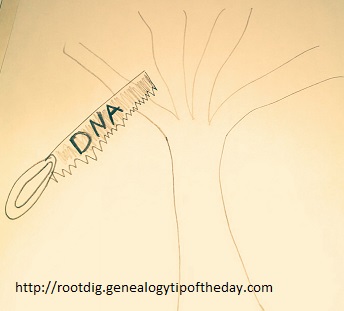Before any analysis of autosomal DNA tests results for genealogical research, it’s suggested that the following things are done (when possible). I realize that in working with DNA kits where there are adoptions or other issues that prevent all these things from being completed–even partially. It’s also recommended that the first DNA kit you work on not be one where the testee is adopted. It’s easier to practice and develop your skills on a kit where the testee knows at least some of their biological parents and grandparents, etc. and focus on those families initially.

- Complete the test kit’s family tree as far back as possible–at least to 5th great-grandparents. You will have blanks. We all have blanks. I have blanks. But the more ancestors you can determine with paper records, the easier the analysis will be for all branches of your tree.
- Work on getting as many descendants of those known ancestors as you can. Consider creating a “working DNA matches analysis tree” for those times where you are “kinda sure” of the connection but where your analysis is not as complete as you would like. The more descendants you have the easier it will be to analyze your results. There are many ways one can get tripped up in tracing these descendants–two of the biggest ones are relationships in census records that are not quite accurate and obituaries that refer to all children (biological, step, and adopted) as children. There are other ways to get tripped up.
- Determine the connection to as many matches as you can, even on families that are not high on your research priority list. That helps to build your analytical skills.
If the match makes no sense and their tree is extensive, there are several possibilities to consider. Those scenarios may exist in the tree of the match, in your own tree, or in both:
- One of you made a mistake in assigning a parentage–either in both parents or in one of them.
- An ancestor was adopted or raised by individuals who were considered their parents but were outside the biological family of that ancestor. The adoptee’s biological parents may have had a connection via marriage or other association with the biological parents, but a DNA test is not going to document that non-biological relationship.
- Both parents were not biologically related to the child because the child was the result of a “short-term relationship” of one of the parents. This detail may not have been passed on to future generations. This “relationship” may not have been a relationship at all.
- An ancestor was raised by one biological parent and another parent who was not biologically related to the ancestor.
- An ancestor was raised by a couple where the mother or father was biologically related to the child (aunt, grandparent, etc. ) but were not their parents.
These last three scenarios may not be easily distinguishable using autosomal DNA matches from the scenario where both “parents of record” were also biological parents of the child, especially if the child in question is of a testee’s great-grandparent or earlier forebear.
There are several options in looking at the tree of the match that makes no sense:
- Look at the shared matches you have with the match whose tree makes no sense. Do you notice any patterns among those shared matches? Are there any of them that you have determined or that may be easier to determine? Do the shared matches with the match whose tree makes no sense seem to come from a certain branch of your family? That might be the place to start looking. If the shared matches have trees, see what names and locations those trees have in common. That might be the place to start looking
- Look at where the individuals in the match whose tree makes no sense tree were born, married, and died. Are there any locations in this tree that coincide with portions of your own tree?
- Consider double-checking the tree of the match whose tree makes no sense. Consider double-checking your own tree as well.
Analysis requires accurate trees. If all trees are inaccurate, determining relationships is difficult if not impossible. When double-checking the tree of the match that makes no sense, errors can occur anywhere but remember that the key thing you are looking for are errors in parent-child relationships.
- Age at first marriage as shown in the tree. Could there have been a previous marriage/relationship that resulted in children were raised as the children of a subsequent spouse?
- Check obituaries of all siblings, parents, etc. who could mention names of survivors, pre-deceased relatives, etc. Are those names all consistent? Survivors by marriage are not necessarily treated equally in all obituaries/death notices and deaths of relatives who died before the marriage that resulted in the step-relationships would not have mentioned those survivors.
- For families that are a little more recent, check engagement announcements, wedding announcements, birth announcements, etc. for mention of relatives. They may make some of the non-biological family relationships a little more clear.
- Estate and probate records often spell out biological relationships more specifically than certain other records–particularly obituaries.
That DNA match to your DNA test is a relative. Determining the relationship is the difficulty.
Learn more about analyzing your AncestryDNA results in my new webinar on “AncestryDNA 2020.”


No responses yet